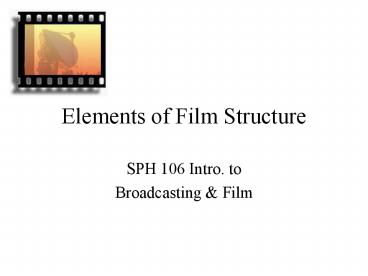Elements of Film Structure PowerPoint PPT Presentation
1 / 20
Title: Elements of Film Structure
1
Elements of Film Structure
- SPH 106 Intro. to
- Broadcasting Film
2
Elements of Film Structure
- StructureThe audio-visual design of the film and
the tools needed to create that design camera,
lighting, set, performance, editing, sound. - ContentThe story, theme, and characterizations.
3
The Film-making Process
4
- The directorcoordinates and organizes the work
of the cast and crew. - The producerhas administrative control over
budget and schedule.
5
Time components of film
- Running timethe full duration of a film.
(Feature films are generally 90-120 minutes.) - Story timethe amount of time the plot covers.
(Could be hours or centuries.)
6
- Internal structural timethe tempo of a film,
which is affected by length of shots and editing
of film. - A shot is the time occurring between the camera
being turned on and shut off.
7
Spatial components
- Framethe projected area on screen, but also an
individual image on a strip of film. - Camera positioning
- Long shot (often used as an establishing shot)
- Medium shot
- Close-up (may be used to show expressions)
8
- Camera angles
- Low (used to make figures appear to tower)
- Medium (eye-level views)
- High (used to diminish subjects in size)
- Canted angle (gives an off-kilter effect)
- Angles must be used in context with scenes.
9
Low angle
10
Medium Angle
11
High angle
12
- Focal lengththe distance between the film and
optical center of the cameras lens. - Normal range lens is 50mm
- Telephoto lens has greater focal length
- Wide-angle lens has shorter focal length
- Zoom lens
13
- Depth of fieldthe amount of area from near to
far that will remain in focus. (Wide-angles have
greater depth of field than telephotos.)
14
- Camera Movement
- Pan and tilt
- Dolly or tracking
- Boom or crane
- Steadicam
- Motion perspectivethe changing distances of
framed objects due to the motion of a moving
camera, such as one with a zoom lens.
15
The Dolly Shot
16
The Zoom
17
Panning
18
Tilting
19
Creative choices
- Flashingexposing film to a small amount of prior
to filming in order to mute color and shadows. - ENR (Ernesto N. Rico)a developing process that
makes shadows darker and edges crisper.
20
Perception of film
- Perceptual transformationthe ability of the
camera to show things in a way that differs from
human visual perception. - Perceptual correspondencethe camera showing
things in a way common with visual perception

